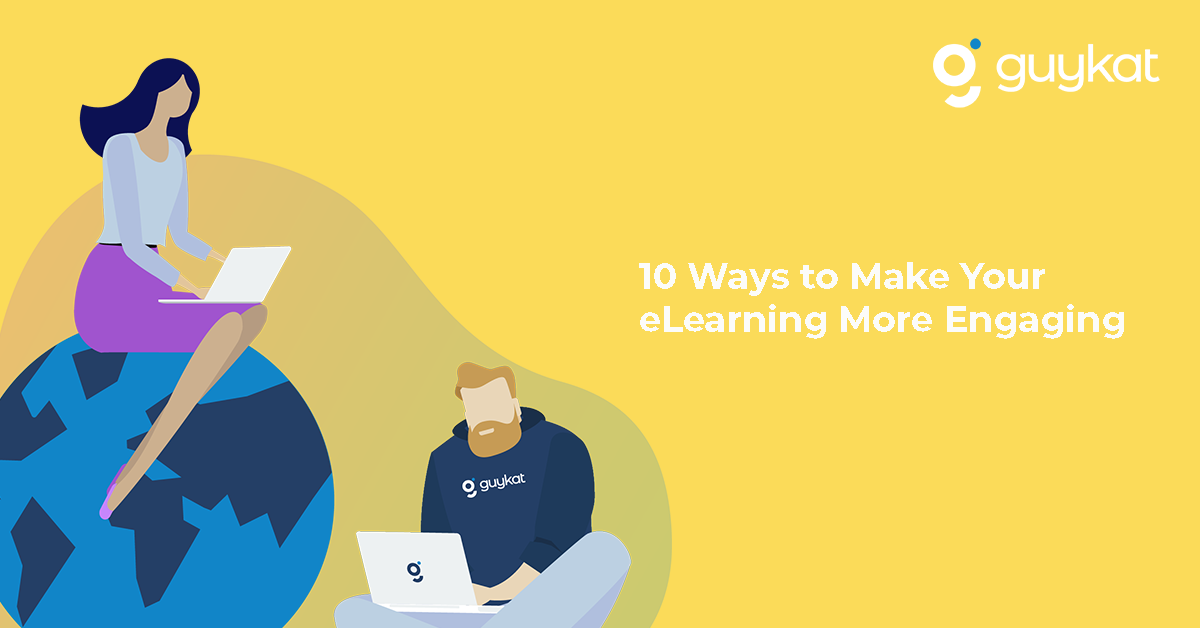The best eLearning engages your learners and makes the complex seem simple. It connects your audience with the content and adds excitement to the learning experience. To help you achieve this, here are a handful of eLearning tips from our eLearning team.
Use creative design
It’s essential to use visuals that help to communicate the subject matter and accommodate the learning journey – overcrowded graphics and images can undermine the experience.
Having a bold colour pallet is an eLearning tip that can also make a difference. Colours can also be used to attract your learner’s attention to key information, represent your branding, or categorise the content.
People are drawn to beauty. No matter how serious the subject, the overall experience of a course can always be enhanced by good aesthetic design.
Use multimedia
If you only plan to use graphics and text, you could just share a PowerPoint. Instead, bring your eLearning content to life using multimedia, such as videos, animations or audio. By keeping it relevant and striking the right balance, you can deepen your learner’s experience and understanding of the content.
Make it interactive
Interactivity demands engagement from learners. Done well, it can make the learning experience immersive.
Different interactions can encourage your learners to discover and deepen their understanding. For example, buttons can reveal new information, while interactive scenarios can build an understanding of real-life applications.
The best interactive eLearning is similar to the old ‘Choose-your-own-adventure’ books*. Every learner will take their own path from start to finish, receive tailored feedback as they progress, but all finish up with the required knowledge at the end.
*Think ‘Black mirror: Bandersnatch’ if you’re of the Netflix generation.
Test your learners
Quizzing and gamification elements can check your learner’s understanding. Providing solid feedback and self-assessment will allow your learners to be active participants. Understanding their strengths and areas for improvement will inform their development. The user interface is as important as the content in getting your learners to explore. Put thought into it.
Related content: Read more about enhancing your learning culture with gamification and rewards.
Encourage your learners to explore
Allow your learners to take the lead and navigate the content. Ensure that the structure of your content flows intuitively and allows them to explore. While you may wish to craft a specific journey, your navigation should not block your learners or hold them back.
Related content: Read more about increasing your learning engagement.
Create a narrative
The best way to engage your learners is to tell a story, rather than simply present information. To learn effectively, your learners need to personally connect with your content and be led on a journey. This is best achieved through skilled writing during the storyboarding phase of a project.
Shout about the benefit to the learner, not your ‘learning objectives’
It’s much easier to motivate your learners if they believe the course will benefit them. The course designer needs to be clear on the learning objectives but these are not the same as learner benefits. Identify the learning objectives when creating the storyboard. Everything in the storyboard should help deliver these objectives. But do not list these at the start of the course. It can often turn off the learner. Instead, you should frame the ‘What’s in it for me?’ question to motivate them.
So, don’t say “During this course, you will learn the detail of the latest law on data protection, you will learn how it applies to a specific subgroup of our clients and you will learn some changes to how we enter data on the system to ensure compliance.” Rather say, “There have been some recent changes in data protection law. There’s a real risk that any of us could accidentally do something that could bring the whole company down. We’re going to tell you what you need to know and do to make sure that person isn’t you!”. Now, the learner is listening.
GuyKat Tip: We encourage our clients to outline their learning objectives in their storyboards, either written explicitly in the script or considered as a thread throughout. This is because it’s vital that every element of the storyboard supports your learners in achieving their goals.
Keep it bite-sized
If appropriate, you should try to create eLearning that is bite-sized and has an overarching objective. Smaller chunks of information will be easier for your learners to digest and retain. By focusing clearly on the essential information, you’re more likely to hold your learner’s attention.
Read more: Less Is More: Organising And Reducing Content To Make It Digestible
Know your learners
Above all, your content must be tailored to your specific learners. Different audiences have different needs. For example, a younger audience may respond well to bold graphics and gamification. You need to get to know your learners and create content that is intuitive to their specific needs and is written with the right ‘voice’.
Be concise
Make it easy for your learners by presenting information in a clear and simple way. Long or unrelated content can be confusing and distract from key messages.
GuyKat Tip: These tips are especially valuable if you’re making new learning content, using authoring tools such as Articulate Storyline or Adobe Captivate. If the content is vital to your business, you may want to engage professional help rather than building the content yourself.


